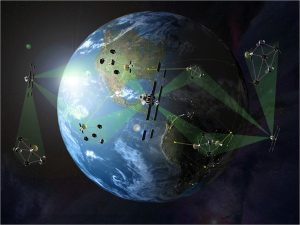Verizon (NYSE: VZ) and AT&T (NYSE: T) both trialed live video calls earlier this week using direct2cell service via AST SpaceMobile (NasdaqGS: ASTS) Low Earth Orbit (LEO) satellite. The trial followed the FCC’s grant of Special Temporary Authority (STA) authorizing testing service of AST SpaceMobile’s commercial BlueBird satellites with unmodified smartphones in the carriers’ low-band wireless spectrum supporting communications without the need of any specialized software or device support or updates.
By incorporating satellite links into their networks, Verizon and AT&T will eventually be able to push their network coverage beyond the population centers to offer voice, data, text, and video services in remote, off-grid locations. This video call demonstration is a step forward toward that goal.
SpaceX is also adding mobile capabilities to its existing network of Starlink satellites, sending up nearly 500 direct2cell birds so far. AST SpaceMobile, on the other hand, is building a dedicated constellation of satellites, known as BlueBirds, specifically designed for direct2cell communications.
The BlueBird satellites’ beams are designed to support a capacity of up to 40 megahertz of spectrum, enabling peak data transmission speeds of up to 120 Mbps. AT&T and Verizon each have 12.5 megahertz of spectrum devoted to satellite communications.
In April 2023, the first two-way voice call over AT&T spectrum was completed. Less than seven months later, the first direct2cell 5G call was made over AT&T spectrum. Meanwhile, last fall, Verizon and Skylo, a provider of non-terrestrial network communications, teamed up to launch a commercial direct-to-device messaging service for Verizon customers so they can stay connected through emergency messaging and location sharing. Coming next year, Verizon will offer the ability to text anywhere via satellite for customers with select devices.
Last December, T‑Mobile opened registration for a direct2cell satellite beta test with the SpaceX Starlink satellites. Initially, T-Mobile Starlink service will deliver text messages. The transmission of picture messages, data and voice calls will come later.
The SpaceX system will operate at around 1900 megahertz and will use large arrays to catch the signals coming from the ground. Alternately, AST SpaceMobile will work at 850 MHz.
“Spacex will operate on frequencies that are higher in the spectrum, which will mean shorter wavelengths, but the service should be comparable between the two,” Joe Madden, principal analyst, Mobile Experts, said.



